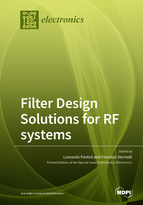Filter Design Solutions for RF systems
A special issue of Electronics (ISSN 2079-9292). This special issue belongs to the section "Circuit and Signal Processing".
Deadline for manuscript submissions: closed (31 May 2020) | Viewed by 45918
Special Issue Editors
Interests: microwave and mm-wave nonlinear circuits; active filters; stability analysis; MMIC
Special Issues, Collections and Topics in MDPI journals
Interests: filters; integrated circuits; MMIC; sensors; sensors interfaces
Special Issues, Collections and Topics in MDPI journals
Special Issue Information
Dear Colleagues,
This Special Issue will focus on the state-of-the-art results in the definition and design of filters for low- and high-frequency applications and systems. Different technologies and solutions are commonly adopted for filter definition, from electrical to electromechanical and mechanical solutions, from passive to active devices, and from hybrid to integrated designs. Aspects related to both theoretical and experimental research in filter design; CAD modeling; novel technologies and applications; and filter fabrication, characterization, and testing will be covered. Potential authors are invited to submit original research articles and review papers on the following topics:
- The modelling, design, and simulation of filters;
- Processes and fabrication technologies for filters;
- The automated characterization and testing of filters;
- Voltage and current-mode filters;
- Integrated and discrete filters;
- Passive and active filters;
- Variable filters, characterization, and tunability.
Prof. Dr. Leonardo Pantoli
Prof. Dr. Vincenzo Stornelli
Guest Editors
Manuscript Submission Information
Manuscripts should be submitted online at www.mdpi.com by registering and logging in to this website. Once you are registered, click here to go to the submission form. Manuscripts can be submitted until the deadline. All submissions that pass pre-check are peer-reviewed. Accepted papers will be published continuously in the journal (as soon as accepted) and will be listed together on the special issue website. Research articles, review articles as well as short communications are invited. For planned papers, a title and short abstract (about 100 words) can be sent to the Editorial Office for announcement on this website.
Submitted manuscripts should not have been published previously, nor be under consideration for publication elsewhere (except conference proceedings papers). All manuscripts are thoroughly refereed through a single-blind peer-review process. A guide for authors and other relevant information for submission of manuscripts is available on the Instructions for Authors page. Electronics is an international peer-reviewed open access semimonthly journal published by MDPI.
Please visit the Instructions for Authors page before submitting a manuscript. The Article Processing Charge (APC) for publication in this open access journal is 2400 CHF (Swiss Francs). Submitted papers should be well formatted and use good English. Authors may use MDPI's English editing service prior to publication or during author revisions.
Keywords
- Filter design
- Filter solutions
- Simulation and modeling
- CAD techniques
- Technology and applications







